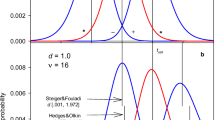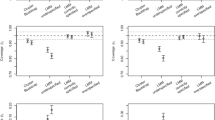Abstract
A very important aspect of virtually any kind of systematic investigation is to be able to identify whether two entities are different, and, almost equivalently, whether they are the same. We need to be sure that measurements made at different time in different places by different experimenters are equivalent. To do this in the social sciences, the procedure of equating is necessary to be able to compare measurements made using different instruments. Small sample sizes can lead to apparent jaggedness in the formulae for equating two quantities, and some kind of smoothing procedure is frequently necessary when dealing with relatively small samples. A large-sample formula is developed for the standard error of moving average smoothed equipercentile equating on a single sample. An example is given of the application in equating two versions of a reading test, and the results are verified using a bootstrap procedure. The large sample formula gives a result that is close to the bootstrap procedure, except at very sparse frequencies.
Similar content being viewed by others
References
Anghoff W.H.: Scales, norms, and equivalent scores. In: Thorndike, R.L. (eds) Educational Measurement, pp. 508–600. American Council on Education, Washington, DC (1971)
Braun H.I., Holland P.W.: Observed test score equating: an analysis of some ETS equating procedures. In: Holland, P.W., Rubin, D.W. (eds) Test Equating, pp. 9–49. Academic Press, New York, NY (1982)
Fairbank B.A.: The use of presmoothing and postsmoothing to increase the precision of equipercentile equating. Appl. Psychol. Meas. 11, 245–262 (1987)
Goldstein H.: Dimensionality, bias, independence and measurement scale problems in latent trait models. Br. J. Math. Stat. Psychol. 33, 234–246 (1980)
Holland, P.W., King, B., Thayer, D.T.: The standard error of equating for the Kernel method of equating score distributions: technical report 89–93. Educational Testing Service, Princeton, NJ (1989)
Kelvin, L. (1824–1907; William Thomson) From Lecture to the Institution of Civil Engineers, 3 May 1883
Kolen M.J., Brennan R.L.: Test Equating: Methods and Practices. Springer Verlag, New York, NY (1995)
Lord F.M.: The standard error of equipercentile equating. J. Edu. Stat. 7, 165–174 (1982)
Rasch G.: Probabilistic Models for Some Intelligence and Attainment Tests. Chicage University Press, Chicago (1960)
Author information
Authors and Affiliations
Corresponding author
Rights and permissions
About this article
Cite this article
Hutchison, D. The standard error of moving average smoothed equipercentile equating. Qual Quant 44, 783–791 (2010). https://doi.org/10.1007/s11135-009-9231-1
Published:
Issue Date:
DOI: https://doi.org/10.1007/s11135-009-9231-1




